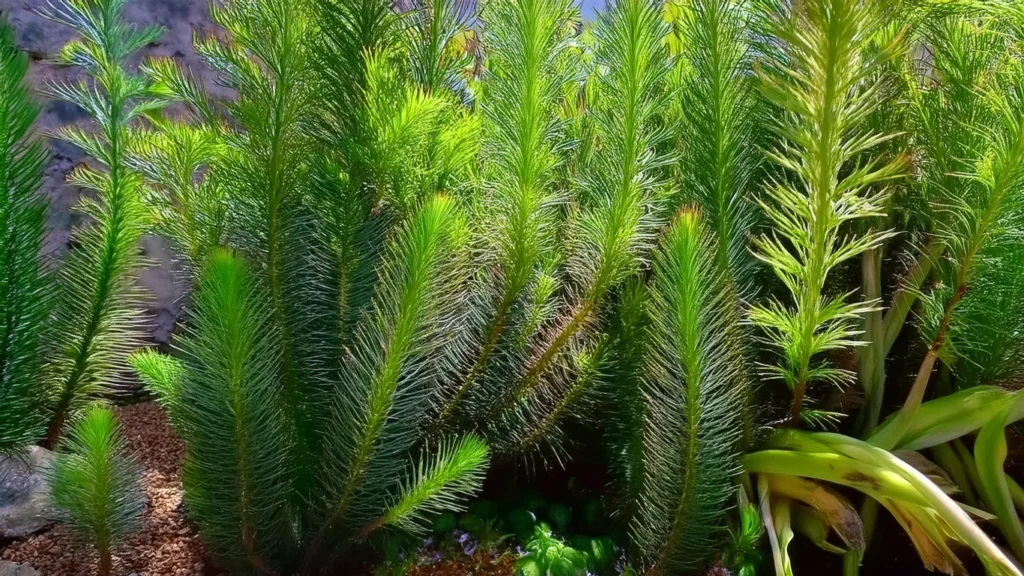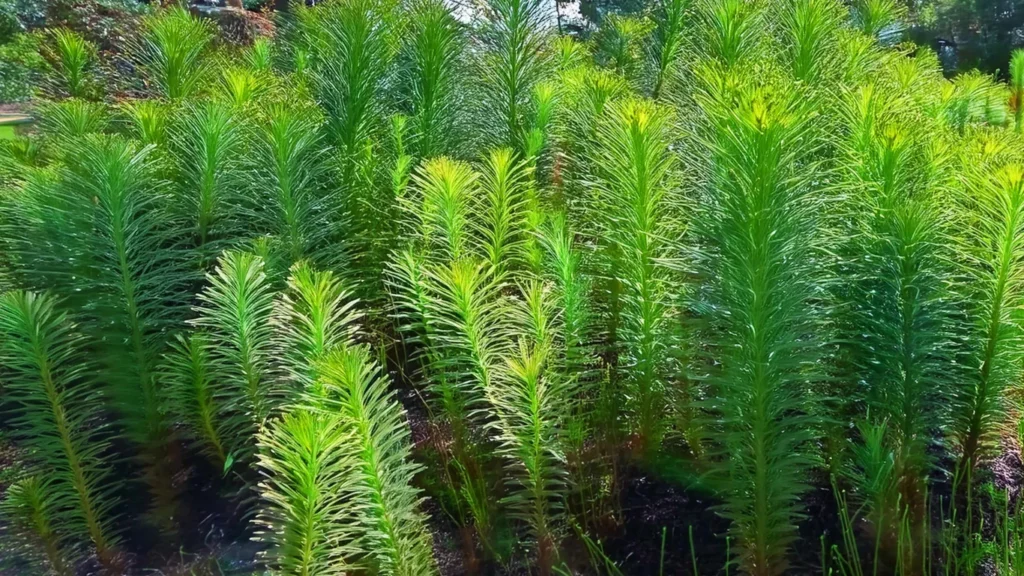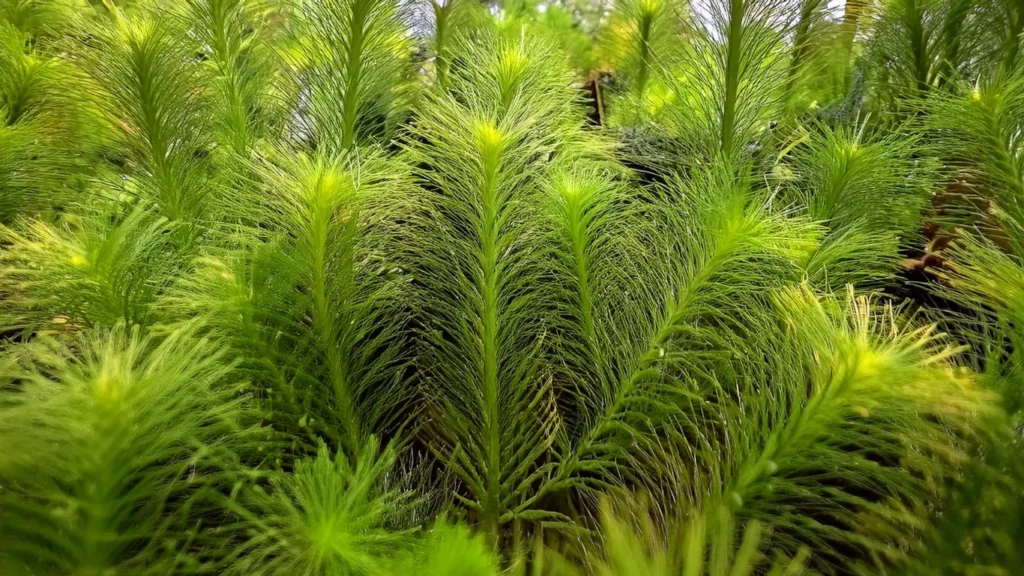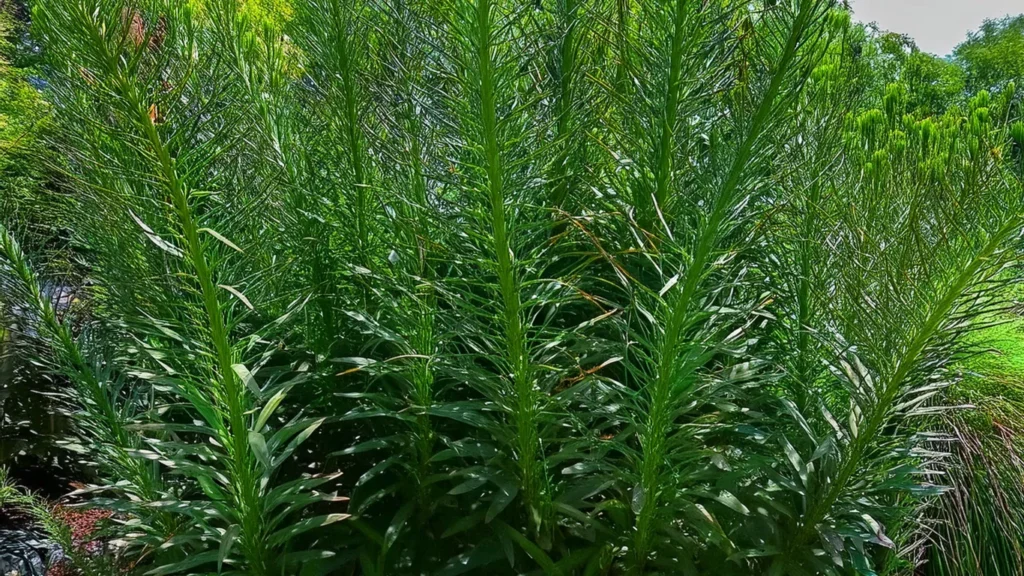In this article, we invite you to discover the breathtaking wonders of Egeria Densa, an extraordinary aquatic plant that graces the underwater world with its natural elegance.
Join us as we delve into the captivating realm of this remarkable plant and unravel its role in aquatic ecosystems, its benefits in aquarium settings, its propagation and growth patterns, as well as its impact on native flora and fauna.
As we venture into the mesmerizing world of Egeria Densa, let us uncover the secrets and marvels of this aquatic gem.

Key Takeaway
- Egeria Densa is a fascinating aquatic plant that brings natural elegance to the underwater world.
- It plays a crucial role in aquatic ecosystems, contributing to water quality and oxygen production.
- Egeria Densa offers numerous benefits in aquariums, enhancing aesthetics and providing shelter for aquatic life.
- Understanding its propagation and growth patterns is essential for successful cultivation and maintenance.
- While Egeria Densa is a marvel, its introduction to new environments can significantly impact native flora and fauna.
Quick Stats
| Attribute | Details |
| Scientific Name | Egeria densa |
| Common Name | Brazilian Waterweed, Anacharis |
| Origin | South America, particularly Brazil |
| Height | Up to 3 meters (10 feet) in ideal conditions |
| pH Range | 6.5 – 7.5 |
| CO2 Requirement | Low to Medium |
| Growth Rate | Fast |
| Care Level | Easy |
| Color Form | Bright green |
| Water Conditions | 15-28°C (59-82°F), adaptable to various water parameters |
| Max Size | Can grow rapidly and may require regular trimming |
| Lighting | Low to High, adaptable to various lighting conditions |
| Supplements | Minimal; benefits from occasional liquid fertilization |
| Placement | Background to Midground |
| Propagation | Through stem cuttings or by releasing offshoots |

What Is Egeria Densa?
Egeria Densa is an aquatic plant that thrives in freshwater environments. Its presence in water bodies plays a vital role in maintaining the balance and health of aquatic ecosystems.
This remarkable plant exhibits unique characteristics and adaptations that allow it to thrive underwater.
Egeria Densa is known for its long, vibrant green stems that extend upwards towards the water’s surface. These stems are densely covered in slender, feathery leaves that provide a lush appearance.
The plant’s multi-branched structure creates a dense and visually appealing presence in the water.
Natural Habitat And Origin
- Egeria densa, commonly known as Brazilian waterweed or Anacharis, is native to South America, particularly the Amazon River basin. It is also found in other regions of South America, including Argentina, Uruguay, and Paraguay. Egeria densa is a submerged aquatic plant that typically grows in freshwater habitats such as rivers, streams, lakes, and ponds with slow to moderate water flow.
- In its natural habitat, Egeria densa forms dense stands of vegetation, providing habitat and refuge for various aquatic organisms. It is adapted to a wide range of environmental conditions, including varying water depths and temperatures. Egeria densa is known for its rapid growth rate and ability to thrive in nutrient-rich waters.
RELATED: Magnificence Of Echinodorus Bleheri To Enhance Your Aquascapes
Physical Characteristics
- One of the notable characteristics of Egeria Densa is its ability to grow both rooted in the sediment and free-floating. This versatility allows it to adapt to different aquatic environments, from lakes and ponds to slow-moving rivers and streams. Additionally, the plant has an efficient system for nutrient absorption, enabling it to extract vital elements from the water.
- One of the unique adaptations of Egeria Densa is its ability to perform photosynthesis underwater. It has specialized leaves that are capable of capturing sunlight, converting it into energy, and releasing oxygen as a byproduct. This process contributes to oxygenation in the water, benefiting both plants and animals in the ecosystem.
- Due to its robust growth and hardiness, Egeria Densa has become a popular choice for aquarium enthusiasts. Its aesthetic appeal, ease of care, and beneficial properties make it an excellent addition to aquarium setups.
- The presence of Egeria Densa in aquariums can enhance the overall visual appeal and provide a natural habitat for aquatic animals.
Lighting Needs Of The Plant
- Intensity: Provide moderate to high-intensity lighting suitable for the growth of aquatic plants. This can be achieved using full-spectrum LED or fluorescent lights designed for planted aquariums.
- Duration: Aim for a photoperiod of around 8 to 10 hours of light per day. Consistent lighting schedules help mimic natural daylight cycles and promote healthy growth.
- Light Spectrum: Use lights with a balanced spectrum that includes both blue and red wavelengths. Blue light encourages compact growth and photosynthesis, while red light promotes flowering and overall plant health.
- Depth Penetration: Consider the depth of your aquarium when selecting lighting. Ensure that light can penetrate to the bottom of the tank to provide sufficient illumination for Egeria densa and other plants, especially in deeper tanks.
- Avoiding Algae: While Egeria densa benefits from moderate to high lighting, be cautious not to provide excessive light that can lead to algae overgrowth. Proper balance between lighting intensity, duration, and nutrient levels is essential to prevent algae problems.
Temperature Parameters For Optimal Growth
- Temperature Range: Egeria densa thrives in a relatively wide temperature range typical of freshwater aquariums. The optimal temperature range for its growth is between 15°C to 28°C (59°F to 82°F).
- Lower Limit: Egeria densa can tolerate cooler temperatures down to around 15°C (59°F). However, growth may slow down at the lower end of this range.
- Upper Limit: While Egeria densa can withstand warmer temperatures, it may not thrive as well in temperatures consistently exceeding 28°C (82°F). Higher temperatures can lead to increased metabolism, which may require more nutrients and oxygen.
- Consistency: Maintain stable temperatures within the recommended range to avoid stressing the plants. Sudden fluctuations in temperature can adversely affect their growth and overall health.
- Thermoregulation: In warmer climates or during hot weather, consider providing adequate cooling measures such as aquarium chillers or fans to keep the water temperature within the optimal range for Egeria densa.

Suitable Water Condition
- pH Level: Egeria densa typically thrives in slightly acidic to neutral water conditions. The ideal pH range for its growth is between 6.5 to 7.5. Avoid extreme pH levels as they can stress the plant and inhibit its growth.
- Water Hardness (GH/KH): Egeria densa is adaptable to a wide range of water hardness levels. It can tolerate both soft and moderately hard water. Aim for a general hardness (GH) and carbonate hardness (KH) between 4 to 15 degrees of hardness (dGH/dKH).
- Temperature: Maintain a water temperature within the range of 15°C to 28°C (59°F to 82°F). Egeria densa thrives in a relatively wide temperature range typical of freshwater aquariums. Ensure temperature fluctuations are minimal to avoid stressing the plant.
- Nutrient Levels: Egeria densa benefits from nutrient-rich water, especially nitrogen and phosphorus, which are essential for its growth. However, excessive nutrient levels can lead to algae overgrowth. Regular water testing and proper fertilization are essential to maintain balanced nutrient levels.
RELATED: Echinodorus Helanthium Tenellus Care Guide For Beginners
Substrate Requirement
- Nutrient-Rich Substrate: While Egeria densa can grow in inert substrates like sand or gravel, it benefits from a nutrient-rich substrate that provides essential nutrients for healthy growth. Consider using specialized aquatic plant substrates or adding root tabs to provide additional nutrients to the roots.
- Fine Gravel or Sand: Egeria densa can be planted in fine gravel or sand substrates, which allow for proper root penetration and anchorage. Make sure the substrate is not too compacted, as it may hinder root growth and nutrient uptake.
- Depth: The substrate depth for Egeria densa is not critical, but a depth of at least 2 to 3 inches (5 to 7.5 centimeters) allows for adequate anchorage and stability of the plants. Deeper substrates may provide better nutrient retention and support for larger root systems.
- Loose Texture: Choose a substrate with a loose texture that allows water circulation and root penetration. Avoid substrates that are too dense or compacted, as they may restrict root growth and lead to nutrient deficiencies.
- Fertilization: Supplement the substrate with root tabs or nutrient-rich substrates designed for aquatic plants to ensure continuous nutrient availability for Egeria densa. These supplements provide essential nutrients directly to the roots, promoting healthy growth and vibrant foliage.
Placement Option For Tanks
- Background Planting: Egeria densa is commonly used as a background plant due to its rapid growth and tall, bushy appearance. Plant it along the back of the aquarium to create a lush green backdrop that adds depth and dimension to the tank.
- Mid-Ground Planting: While Egeria densa is typically used as a background plant, it can also be placed in the mid-ground of the aquarium if trimmed regularly to maintain a manageable size. This placement adds texture and visual interest to the middle portion of the tank.
- Floating Plant: Egeria densa can be allowed to float freely at the water’s surface, where it will create dense surface cover. This placement provides shade and shelter for fish and other aquatic inhabitants while also helping to oxygenate the water.
- Foreground Planting (in larger tanks): In larger aquariums, Egeria densa can be planted in the foreground if trimmed regularly to prevent it from overshadowing smaller plants. This placement adds a lush, natural look to the front of the tank.
- Around Hardscape: Plant Egeria densa around hardscape features such as rocks or driftwood to soften their appearance and create a natural transition between the hardscape and the surrounding plants.
Recommended Tank Size
- Small Tanks: Egeria densa can be suitable for smaller aquariums, such as those with a capacity of 10 gallons (approximately 38 liters) or more. In smaller tanks, consider planting fewer specimens and regularly trimming the plants to prevent overcrowding.
- Medium Tanks: For medium-sized aquariums ranging from 20 to 50 gallons (approximately 75 to 190 liters), Egeria densa can be used as a background plant to create a lush green backdrop. Planting multiple specimens can help fill the space and create a dense, natural look.
- Large Tanks: In larger aquariums exceeding 50 gallons (approximately 190 liters), Egeria densa can be planted in greater numbers to create a visually stunning display. Consider planting along the back and sides of the tank to maximize the impact of this fast-growing plant.
- Community Tanks: Egeria densa is often used in community tanks with a variety of fish species. When selecting the tank size for a community setup, consider the needs and compatibility of the fish species as well as the space requirements of the plants.

Suitable Tank Mates
Community Fish: Many peaceful community fish species can thrive alongside Egeria densa. Examples include:
- Tetras (e.g., Neon Tetras, Cardinal Tetras)
- Rasboras (e.g., Harlequin Rasboras, Chili Rasboras)
- Livebearers (e.g., Guppies, Platies, Swordtails)
- Corydoras Catfish
- Dwarf Gouramis
- Danios (e.g., Zebra Danios, Leopard Danios)
Shrimp and Snails: Many freshwater shrimp and snail species can be excellent tank mates for Egeria densa, as they help clean algae and detritus while coexisting peacefully with the plants. Examples include:
- Cherry Shrimp
- Amano Shrimp
- Nerite Snails
- Malaysian Trumpet Snails
Bottom Dwellers: Bottom-dwelling fish species can complement Egeria densa by occupying the lower levels of the aquarium. Examples include:
- Otocinclus Catfish
- Corydoras Catfish
- Bristlenose Plecos
- Kuhli Loaches

Nutritional Needs Of The Plant
Egeria densa, commonly known as Brazilian waterweed or Anacharis, has relatively low nutritional requirements compared to some other aquatic plants. However, it still requires essential nutrients to support its growth and health. Here are the key nutritional needs of Egeria densa:
Macronutrients
- Nitrogen (N): Essential for chlorophyll production and overall plant growth. Nitrogen is a major component of proteins, which are vital for plant structure and function.
- Phosphorus (P): Important for energy transfer, root development, and flower formation. Phosphorus is a key component of nucleic acids and ATP, the energy currency of the cell.
- Potassium (K): Facilitates enzyme activation, osmoregulation, and overall plant vigor. Potassium is involved in various physiological processes, including photosynthesis and protein synthesis.
Micronutrients
- Iron (Fe): Necessary for chlorophyll synthesis and enzyme activity. Iron is a critical micronutrient for plants, and deficiency can lead to chlorosis (yellowing of leaves).
- Magnesium (Mg): Essential for chlorophyll structure and function. Magnesium is a central component of the chlorophyll molecule, which is responsible for photosynthesis.
- Calcium (Ca): Important for cell wall structure and integrity. Calcium plays a role in cell division, membrane stability, and nutrient uptake.
Egeria Densa Cultivation Tips
- Lighting: Provide moderate to high-intensity lighting suitable for the growth of aquatic plants. Egeria densa thrives in well-lit environments, so ensure that your aquarium receives adequate lighting for at least 8 to 10 hours per day. Full-spectrum LED or fluorescent lights with a color temperature around 6500K are suitable for promoting healthy growth.
- Nutrient-Rich Substrate: While Egeria densa can grow in inert substrates like sand or gravel, it benefits from a nutrient-rich substrate that provides essential nutrients for healthy growth. Consider using specialized aquatic plant substrates or adding root tabs to provide additional nutrients to the roots.
- Water Parameters: Maintain stable water parameters within the recommended range for Egeria densa. This includes a pH level between 6.5 to 7.5, water hardness (GH/KH) between 4 to 15 degrees, and a temperature between 15°C to 28°C. Regular water changes and monitoring of water parameters are essential for plant health.
- CO2 Supplementation (Optional): While not strictly necessary, CO2 supplementation can enhance the growth of Egeria densa, especially in high-tech planted aquarium setups. CO2 injection can promote lush growth and vibrant coloration in the plants.

Propagation Tips
- Stem Cuttings: Select healthy stems, trim just below a leaf node, remove lower leaves, and plant in the substrate. Ensure the cuttings are spaced apart to allow for growth and prevent overcrowding.
- Side Shoots: Carefully remove side shoots from the parent plant, ensuring each has a portion of the main stem and leaves, then plant in the substrate. Space the side shoots appropriately to encourage healthy growth.
- Optimal Conditions: Provide adequate lighting, nutrient-rich substrate, and stable water parameters to support healthy growth. Maintain proper water circulation to prevent stagnant areas and promote nutrient uptake.
- Rooting: Monitor root development within a week after planting. Expect some leaf loss initially, but new growth should follow. Ensure the substrate is well-aerated to facilitate root establishment.
- Maintenance: Regularly prune to remove dead or decaying leaves and monitor for pests and diseases. Maintain optimal water quality and nutrient levels to support plant health and prevent algae overgrowth.
Role Of Egeria Densa In Aquatic Ecosystems
- Egeria densa, also known as Brazilian waterweed, plays a crucial role in maintaining the balance and health of aquatic ecosystems. Its presence in these environments is significant, as it contributes to water quality, nutrient cycling, and oxygen production.
- One of the key contributions of it to aquatic ecosystems is its ability to absorb excess nutrients from the water. As an aquatic plant, it naturally takes up nutrients like nitrogen and phosphorus, reducing their availability for algae and other organisms that can cause imbalances in the ecosystem.
- By removing these nutrients, Egeria densa helps prevent algal blooms and maintains water clarity.
- Moreover, Egeria densa plays a vital role in oxygen production. Through photosynthesis, this aquatic plant releases oxygen into the water, creating an oxygen-rich environment that supports the survival of various aquatic organisms.
- The oxygen produced by Egeria densa is particularly essential for fish and other animals that rely on dissolved oxygen to breathe.
- Egeria densa also provides habitat and food sources for a wide range of aquatic organisms. Its dense vegetation shelters and breeds fish, invertebrates, and microorganisms.

Conclusion
Throughout this article, we have explored the wonders of Egeria densa, a truly remarkable aquatic plant. We have highlighted its ecological role in aquatic ecosystems, its numerous benefits in aquariums, and its unique propagation and growth patterns.
Additionally, we have discussed the potential impact of it on native flora and fauna, and the importance of preservation efforts to ensure the sustainability of its habitats.
It’s ecological significance cannot be understated. As a key player in aquatic ecosystems, it contributes to water quality by aiding nutrient cycling and oxygen production.
Its ability to enhance the aesthetic appeal of aquariums makes it a favorite among aquarists while also providing shelter and food for aquatic animals.
However, it is essential to consider the potential risks associated with Egeria densa’s presence. As an invasive species, it can harm native plants and animals, highlighting the need for careful management and conservation measures.
By understanding and appreciating the delicate balance of Egeria densa’s role in natural and artificial aquatic environments, we can strive towards its responsible cultivation and preservation.
Frequently Asked Questions
What Is Egeria Densa, And Where Is It Commonly Found?
Egeria densa, commonly known as Brazilian waterweed or Elodea densa, is a submerged aquatic plant native to South America. It has been introduced to various regions worldwide and is often found in freshwater habitats such as lakes, ponds, rivers, and streams.
What Are The Main Characteristics Of Egeria Densa?
This plant typically features long, slender stems with whorls of lance-shaped leaves. Its submerged growth habit allows it to thrive in water depths ranging from shallow to several meters. The plant can form dense mats, often creating significant challenges for water flow and ecosystem balance.
What Are The Ecological Impacts Of Egeria Densa Invasion?
The invasion of this plant can have several ecological impacts, including altering water chemistry, reducing biodiversity by outcompeting native species, altering habitat structure, and affecting nutrient cycling. Dense mats of Egeria densa can also impede recreational activities such as boating, fishing, and swimming.
How Can Egeria Densa Be Controlled Or Managed?
Controlling this plant often involves a combination of mechanical, chemical, and biological methods. Mechanical methods include manual removal or the use of machinery to harvest the plants. Chemical control involves the application of herbicides, while biological control may involve the introduction of herbivorous fish or insects that feed on Egeria densa.
Is Egeria Densa Beneficial In Any Way?
While this plant is considered an invasive species in many regions, it can also provide some benefits. It can help improve water quality by absorbing nutrients and stabilizing sediments. Additionally, it may offer habitat and food sources for certain aquatic organisms. However, its negative impacts often outweigh these potential benefits in invaded ecosystems.
- Unveiling The Wonders Of Riccia Fluitans In Aquascapes - August 7, 2024
- Vallisneria Gigantea Var. Guide To Care And Cultivation At Home - July 31, 2024
- Vesicularia Dubyana Care & Growth Guide Tips For Beginner Gardeners - July 30, 2024
